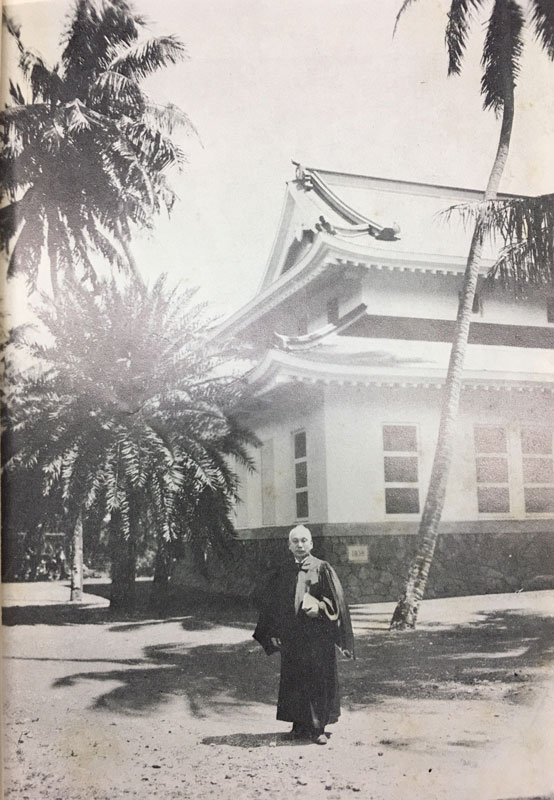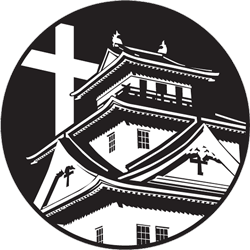We have all heard people say that when they first saw our church they thought it was a Buddhist church or temple. You may have thought that yourself. Have you ever wondered why our Makiki Christian Church tower building was built like a Japanese castle?
The following are the thoughts of Rev. Takie Okumura, our founder, from A Collection of Sermons (Okumura, 1974) and Seventy Years of Divine Blessings (Okumura, 1939), about the plans and building of our church’s castle tower.
Okumura’s Inspiration for Our Church Tower
“I was born in Kochi, Tosa. Since our residence from the old feudal days was situated close to Kochi Castle, I went there frequently to play. At times, I climbed to the tower; at other times I gathered water chestnuts in the moat. So in my youth the castle, looming high in front, was in constant view as I went to school every morning.”
“In August, 1894, at the age of 29, I came to Hawaii. Even after I had become a kamaaina, I occasionally thought about the old country and each time I did so memories of Kochi loomed high.” (Okumura, 1974, pg.237).
“During the past twenty years, I had been collecting some 100 pictures, photos, postal cards and designs of old castles in Japan.”
“Unexpectedly, when the matter of erecting a new church edifice came up in the church council, a woman member suggested that we build it in the form of a castle – a suggestion which helped me realize my long cherished hope, and enabled us to see, in the midst of Honolulu, the lofty castle tower. The crest of Makiki Church tower is patterned after the Otakasaka Castle (original name of Kochi Castle) of my home town in Japan, a castle upon which I gazed since my boyhood, each morning and afternoon, and from which I received a thrill and inspiration in life.” (Okumura, 1939, pg. 10, 169).
“. . . . For the architectural design, I chose to pattern it upon the Japanese castle. One reason for this choice was that we wanted to build a purely Japanese style building in the heart of the city, one that would figure prominently in the city’s beauty and serve as a token of our appreciation of the land . . . . Another deeper reason for the choice was the occurrence of Bible verses referring to God as our fortress nine times in the Old Testament. . . . Also, verses referring to God as a high tower or a strong tower. . . . The fortress and the high tower both give a feeling of veneration to people who look up at them and inspire a feeling of confidence and reliance. They were, therefore, chosen by apostles of old as the most appropriate symbols of their faith in Almightly God. (Additionally), in view of the historical fact that the tenshukaku (the topmost section) of the first Japanese castle was specifically built to enshrine God, I felt that the architectural form of the Japanese castle would be most appropriate in the building of a purely Japanese style church. . . . The tenshukaku of the new church was to be modeled after the tower of Kochi Castle.” (Okumura, 1974, pg. 243).
As soon as the plans were completed, we submitted them to a committee of the Hawaiian Board of Missions for its approval. Some members questioned the propriety of a Christian church, which stands for peace, to model its building after a castle, traditionally a symbol of war. So I explained that our castle was not for aggression but for defense. “God is our fortress,” says the Bible. “God is our refuge.” A castle is a place of refuge, a place to obtain safety and protection. Moreover, in Japan the structure that first enshrined the Christian God was the tenshukaku. For these reasons, we had decided to build a church with the castle as its model. Dr. Theodore Richards, a member of the committee, commented, “Unlike most Japanese who tend to throw overboard everything Japanese and imitate all things American when they become Christians, you try to preserve the good heritage of the Japanese and Christianize it. That’s great!” Thereupon the entire committee endorsed my plans for the new church and voted to lend its support to our project (Okumura, 1974, pg. 244).
Construction was begun in 1931 and completed in November, 1932. . . . From the time the fund drive was started, all matters concerning the construction of the new church were being handled by a special committee, so I urged the rest of the congregation to be less concerned about the building drive and to concentrate more on personal evangelism so that when the time came to dedicate the new church, they would have a large number of candidates to be baptized. This would mean the dedication of a large number of living temples of God. This campaign bore fruit. On November 13, the Sunday following the dedication ceremonies, a total of 149 persons were baptized in the morning and evening (Okumura, 1974, pg. 245).

So, it seems that although our church was physically modeled after a Japanese castle, the thoughts and sentiments that went into designing and constructing the tower had deep Christian roots and was based on clear and strong biblical values.
We have heard much about our revered founder, Takie Okumura. He was the shepherd and inspirational leader of hundreds of our staunch Makiki Christian Church brothers and sisters, as well as the driving force behind the building of our church castle tower. There are many reasons for us to be proud of our heritage and honored by his presence in our past.
Have you ever wondered if there was an even greater source of real strength and power (besides God) behind this most venerable man? That answer in the next “From the Archives . . . .” article. Stay tuned!



